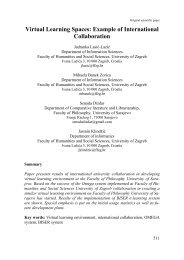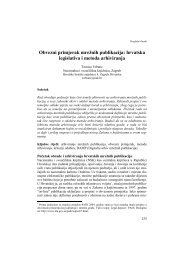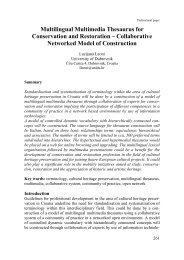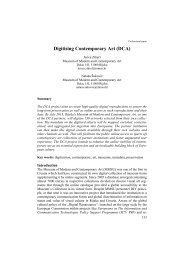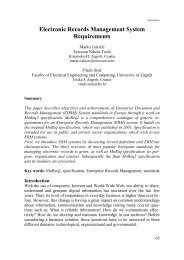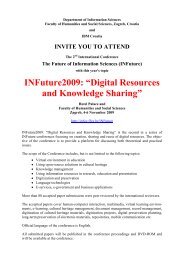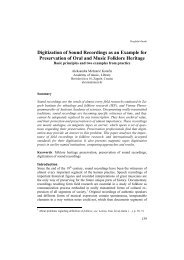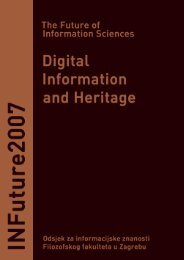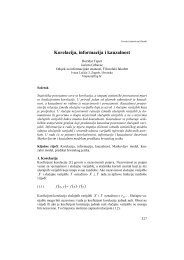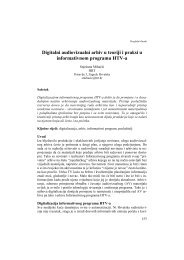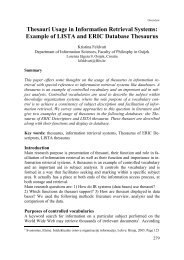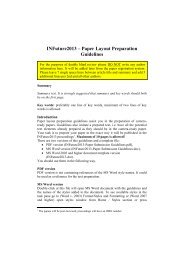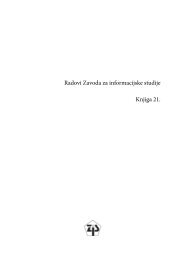Slovenian Biographical Lexicon ? From a Digital Edition to an On ...
Slovenian Biographical Lexicon ? From a Digital Edition to an On ...
Slovenian Biographical Lexicon ? From a Digital Edition to an On ...
You also want an ePaper? Increase the reach of your titles
YUMPU automatically turns print PDFs into web optimized ePapers that Google loves.
Professional paper<br />
<strong>Sloveni<strong>an</strong></strong> <strong>Biographical</strong> <strong>Lexicon</strong> – <strong>From</strong> a <strong>Digital</strong><br />
<strong>Edition</strong> <strong>to</strong> <strong>an</strong> <strong>On</strong>-Line Application<br />
Summary<br />
J<strong>an</strong> Jona Javoršek<br />
Department of Experimental Particle Physics<br />
Jožef Stef<strong>an</strong> Institute<br />
Jamova cesta 39, Ljublj<strong>an</strong>a, Slovenia<br />
j<strong>an</strong>.javorsek@ijs.si<br />
Petra Vide Ogrin<br />
<strong>Sloveni<strong>an</strong></strong> Academy of Sciences <strong>an</strong>d Arts, Library<br />
Novi trg 3, Ljublj<strong>an</strong>a, Slovenia<br />
petra.vide@zrc-sazu.si<br />
Tomaž Erjavec<br />
Department of Knowledge Technologies<br />
Jožef Stef<strong>an</strong> Institute<br />
Jamova cesta 39, Ljublj<strong>an</strong>a, Slovenia<br />
<strong>to</strong>maz.erjavec@ijs.si<br />
We presents the digitization of <strong>Sloveni<strong>an</strong></strong> <strong>Biographical</strong> <strong>Lexicon</strong> (SBL), <strong>an</strong> extensive<br />
publication that used bio-bibliographical methods <strong>to</strong> provide synthetic assessments<br />
of work <strong>an</strong>d signific<strong>an</strong>ce of his<strong>to</strong>rical figures on the basis of primary<br />
sources. SBL has been out of print for a long time, but the publication has been<br />
seen as <strong>an</strong> import<strong>an</strong>t resource for encyclopaedic <strong>an</strong>d reference editions <strong>an</strong>d research<br />
in the <strong>Sloveni<strong>an</strong></strong> hum<strong>an</strong>ities, social sciences <strong>an</strong>d his<strong>to</strong>ry of the natural<br />
sciences. Therefore, <strong>Sloveni<strong>an</strong></strong> Academy of Sciences <strong>an</strong>d Arts (SASA) <strong>an</strong>d the<br />
Scientific Research Centre of the SASA decided <strong>to</strong> produce a freely available<br />
on-line digital re-edition of SBL. In the process of digitalization, m<strong>an</strong>ually corrected<br />
OCR has been semi-au<strong>to</strong>matically converted <strong>to</strong> XML-based Text Encoding<br />
Initiative format (TEI P5). Its extensive <strong>an</strong>notation vocabulary, notably<br />
from the biographical <strong>an</strong>d prosopographical modules, has been used <strong>to</strong> markup<br />
as much data as possible. The resulting XML document has become the data<br />
resource of <strong>an</strong> online digital reposi<strong>to</strong>ry based on Fedora Commons platform,<br />
where we implemented <strong>an</strong> infrastructure of XML processing methods on <strong>to</strong>p of<br />
native relationships <strong>an</strong>d a Lucene/SOLR based search engine <strong>to</strong> produce a fullfledged<br />
web application <strong>an</strong>d search engine with browser, metadata <strong>an</strong>d web<br />
application interfaces.<br />
251
INFuture2009: “<strong>Digital</strong> Resources <strong>an</strong>d Knowledge Sharing”<br />
Key words: digital library, encyclopaedia, TEI-XML markup, document reposi<strong>to</strong>ry,<br />
Fedora Commons, XSLT workflows, search, Lucene, SOLR<br />
Introduction<br />
The <strong>Sloveni<strong>an</strong></strong> Bibliographical <strong>Lexicon</strong> (SBL, 1925-1991) has been conceived<br />
as a publication that was <strong>to</strong> give <strong>an</strong> accurate picture of Slovenia’s cultural life,<br />
from its beginnings up <strong>to</strong> the contemporary time by including everybody who<br />
participated in the cultural development, either of <strong>Sloveni<strong>an</strong></strong> origin, born on<br />
<strong>Sloveni<strong>an</strong></strong> soil or influencing <strong>Sloveni<strong>an</strong></strong> cultural life.<br />
This broad aim resulted in the proposed list of 2,335 names, mostly from the<br />
fields of hum<strong>an</strong>ities <strong>an</strong>d social sciences, proposed by the original edi<strong>to</strong>rial<br />
board. In its long his<strong>to</strong>ry, this list has been ch<strong>an</strong>ged <strong>an</strong>d exp<strong>an</strong>ded: at first due <strong>to</strong><br />
the need <strong>to</strong> include other disciplines <strong>an</strong>d areas, such as the natural sciences, later<br />
due <strong>to</strong> ch<strong>an</strong>ges in perspective, especially the WW2, when particip<strong>an</strong>ts in recent<br />
had <strong>to</strong> be included <strong>an</strong>d the focus has been shifted <strong>to</strong> include “increasing development<br />
of natural sciences, modern technologies <strong>an</strong>d their applications, as part<br />
of the spiritual superstructure” (SBL, vol. 15, 1991). In spite of several eliminations<br />
from the original list, the final publication in 1991 comprised as m<strong>an</strong>y as<br />
5,031 biographical entries, with more th<strong>an</strong> 5,100 persons covered. Since the<br />
publication was published sequentially, it is import<strong>an</strong>t <strong>to</strong> consider that the criteria<br />
for different published volumes have therefore varied signific<strong>an</strong>tly.<br />
The second aim of the publication was <strong>to</strong> be both informative <strong>an</strong>d exhaustive,<br />
so much subst<strong>an</strong>tial information had <strong>to</strong> be included in rather short articles (with<br />
several longer exceptions) <strong>an</strong>d it has been decided that the data in the articles<br />
had <strong>to</strong> be been checked against relev<strong>an</strong>t his<strong>to</strong>rical materials <strong>an</strong>d pre-existing<br />
publications., e.g. biographical <strong>an</strong>d other dates are always compared <strong>to</strong> dates in<br />
registers <strong>an</strong>d other primary documents, literary citations are compared with<br />
originals, sources are cited at the end of the articles <strong>an</strong>d the publication includes<br />
<strong>an</strong> index of all person names that appear in the articles <strong>an</strong>d a list of abbreviations.<br />
As a result, SBL contains a surprising amount of high-quality information <strong>an</strong>d<br />
references <strong>an</strong>d remains <strong>to</strong> this day a precious resource for encyclopaedic <strong>an</strong>d<br />
reference editions <strong>an</strong>d research in the <strong>Sloveni<strong>an</strong></strong> hum<strong>an</strong>ities, social sciences <strong>an</strong>d<br />
his<strong>to</strong>ry of the natural sciences. It had, however, two severe drawbacks: the<br />
original edition has quickly become difficult <strong>to</strong> find <strong>an</strong>d the information, once<br />
published, has never been updated, so much care has <strong>to</strong> be taken <strong>to</strong> consider the<br />
time of publication of each article. The present project of digitalization of SBL<br />
has been started by the <strong>Sloveni<strong>an</strong></strong> Academy of Sciences <strong>an</strong>d Arts (SASA) <strong>an</strong>d<br />
the Scientific Research Centre of the SASA <strong>to</strong> make this precious resource<br />
available again, this time in the form of a freely accessible on-line edition, <strong>an</strong>d<br />
has been based on previous similar projects (cf. Erjavec, Ogrin, 2005). We aim<br />
<strong>to</strong> describe here the steps taken on the path from the original publication <strong>to</strong>wards<br />
a fully interactive, searchable <strong>an</strong>d cross-indexed on-line edition. The first<br />
252
J. J. Javoršek, P. Vide Ogrin, T. Erjavec, <strong>Sloveni<strong>an</strong></strong> <strong>Biographical</strong> <strong>Lexicon</strong><br />
steps of the process, from digitalization using OCR <strong>an</strong>d m<strong>an</strong>ual revision <strong>to</strong><br />
semi-au<strong>to</strong>matic encoding <strong>an</strong>d mark-up in the form of Text Encoding Initiative<br />
XML document (TEI P5), will be summarized (see Ogrin, Erjavec, 2007 for a<br />
more detailed treatment of this <strong>to</strong>pic) before we consider the methodology <strong>an</strong>d<br />
implementation of <strong>an</strong>d on-line digital reposi<strong>to</strong>ry for the digital edition that c<strong>an</strong><br />
function as a flexible web application. We will present several possibilities offered<br />
by our implementation, some of which remain for further experiments. In<br />
closing, we wish <strong>to</strong> present some possible solutions <strong>to</strong> the hardest problems encountered<br />
in this work, from normalization of data <strong>an</strong>d abbreviation exp<strong>an</strong>sion<br />
<strong>to</strong> the question of treatment of the original in view of the necessities of every<br />
day users who wish <strong>to</strong> have access <strong>to</strong> updated information. It is worth noting at<br />
this point that the digital edition in current form is available for testing <strong>an</strong>d the<br />
reader c<strong>an</strong> follow the presentation at the following URL: http://nl.ijs.si/fedora/<br />
sbl/.<br />
<br />
<br />
<br />
<br />
<br />
Abraham<br />
škof<br />
<br />
duhovnik<br />
<br />
26. maja 994<br />
<br />
<br />
<br />
<br />
<br />
Kos<br />
Milko<br />
<br />
<br />
<br />
Abraham, škof v Freisingu na Bavarskem, izvoljen<br />
po smrti škofa Lamberta (u. 19. sept. 957), posvečen 21.<br />
Figure 1: An SBL article excerpt with its TEI XML encoding<br />
Text Encoding Initiative: the Data Source<br />
Encoding of SBL is based on open st<strong>an</strong>dards <strong>an</strong>d software, in particular the<br />
Text Encoding Initiative P5 Guidelines, since TEI has been used as the encoding<br />
st<strong>an</strong>dard for the digitalization of the <strong>Sloveni<strong>an</strong></strong> Bibliographic <strong>Lexicon</strong>.<br />
TEI produced recommendations or guidelines for the creation <strong>an</strong>d processing of<br />
electronic texts for better interch<strong>an</strong>ge <strong>an</strong>d integration of scholarly textual data in<br />
all l<strong>an</strong>guages <strong>an</strong>d from all periods (Burnard, 1988). We used the latest edition of<br />
TEI Guidelines, TEI P5, finalized in 2007 (Burnard, Baum<strong>an</strong>, 2007), since it<br />
provides import<strong>an</strong>t new encoding features, including new support for m<strong>an</strong>uscript<br />
descriptions, multimedia <strong>an</strong>d graphics, st<strong>an</strong>d-off <strong>an</strong>notation, representa-<br />
253
INFuture2009: “<strong>Digital</strong> Resources <strong>an</strong>d Knowledge Sharing”<br />
tion of data pertaining <strong>to</strong> people <strong>an</strong>d places <strong>an</strong>d improved specifications for encoding<br />
textual alternatives. Additionally, TEI P5 takes adv<strong>an</strong>tage of the power<br />
of XML schema l<strong>an</strong>guages, so that other XML tag-sets, such as MathML or<br />
SVG, c<strong>an</strong> now be referenced from within a TEI document <strong>an</strong>d a TEI document<br />
c<strong>an</strong> be embedded within other types of XML documents, such as METS <strong>an</strong>d<br />
MODS records (Burnard, Baum<strong>an</strong>, 2007), which turned out <strong>to</strong> be crucial for the<br />
implementation of our on-line reposi<strong>to</strong>ry, since this makes TEI a well-behaved<br />
XML citizen, able <strong>to</strong> take part in <strong>an</strong>y, however complex, XML processing<br />
chains <strong>an</strong>d composite documents.<br />
XML Data Source Structure<br />
The vast majority of SBL articles present information on the life <strong>an</strong>d actions of<br />
a single person, while some describe well known families, detailing life <strong>an</strong>d<br />
work of several members of the family. An article usually starts with the name<br />
of the person or the family, its vari<strong>an</strong>ts, mostly those used <strong>to</strong>wards the end of<br />
their life or the most generally used, followed by a chronological summary of<br />
the person’s life <strong>an</strong>d activity, including birth, death, locations, occupations, activities<br />
etc. An article may consist of one (usually) or m<strong>an</strong>y paragraphs, depending<br />
on the exhaustiveness of the article, <strong>an</strong>d is written in dense l<strong>an</strong>guage,<br />
using abbreviations wherever possible, ending with a brief bibliography <strong>an</strong>d<br />
other materials relev<strong>an</strong>t <strong>to</strong> the person, such as portraits or pho<strong>to</strong>graphs.<br />
The text of the articles has been digitized <strong>an</strong>d m<strong>an</strong>ually revised <strong>to</strong> fix OCR errors<br />
before it was au<strong>to</strong>matically converted in<strong>to</strong> the basic TEI-XML format. In<br />
the next stage, segments of text that needed <strong>to</strong> be marked up but could not be<br />
identified au<strong>to</strong>matically had <strong>to</strong> be tagged m<strong>an</strong>ually, in particular with details<br />
such as different vari<strong>an</strong>ts of names (linguistic <strong>an</strong>d orographic variations, married<br />
names, ecclesiastic names <strong>an</strong>d titles, pseudonyms, complex name parts in<br />
the case of foreign names <strong>an</strong>d names with denotation of nobility etc.), making<br />
the process slow <strong>an</strong>d error-prone. Since the original data was not normalized,<br />
considerable effort had <strong>to</strong> be spent <strong>to</strong> achieve high quality TEI XML mark up,<br />
<strong>an</strong>d some work with data normalization is still ongoing. (The major aspects of<br />
this conversion process have been reported in more detail in Vide Ogrin, Erjavec<br />
2007). In this m<strong>an</strong>ner, essential information about the subject of the article<br />
<strong>an</strong>d its bibliographical section have been encoded with special purpose elements<br />
from TEI P5 biographical <strong>an</strong>d prosopographical modules, representing<br />
each article as a element starting with a element, which<br />
contains the detailed information on the subject of the article (names, sex,<br />
birth/death date <strong>an</strong>d location, locations of activities, occupations or activities<br />
etc.), but also meta data, (volume <strong>an</strong>d year of the first publication, author of the<br />
article, revision status etc.). This element is followed with one or more <br />
elements with the article text <strong>an</strong>d a element with the extracted bibliographical<br />
data.<br />
254
J. J. Javoršek, P. Vide Ogrin, T. Erjavec, <strong>Sloveni<strong>an</strong></strong> <strong>Biographical</strong> <strong>Lexicon</strong><br />
Obviously, the actual structure <strong>to</strong> a certain extent depends on the information of<br />
that particular article, <strong>an</strong>d so the type <strong>an</strong>d number <strong>an</strong>d elements varies considerably<br />
(ie. marriage, ordination, exile, further education, number of occupations,<br />
residence, active period etc.). This makes <strong>an</strong>y mapping in<strong>to</strong> a more formal<br />
structure, i.e. a relational database, at least awkward.<br />
There is a number of further details that could be extracted from the text but<br />
meticulous m<strong>an</strong>ual intervention would be required <strong>to</strong> achieve suitable accuracy.<br />
The most import<strong>an</strong>t of these are activities undergone by the person, encodable<br />
in the tag or tags, <strong>an</strong>d locations <strong>an</strong>d times of these activities, encodable<br />
by the tag.<br />
Ana<strong>to</strong>my of <strong>an</strong> XML-based Document Reposi<strong>to</strong>ry<br />
We have evaluated a number of possible platforms <strong>to</strong> serve as the base of <strong>an</strong> online<br />
web edition of SBL with integrated query <strong>an</strong>d search <strong>to</strong>ols. <strong>On</strong>e possibility<br />
considered was PhiloLogic 1 , a full-text search, <strong>an</strong>alysis, <strong>an</strong>d retrieval <strong>to</strong>ol developed<br />
by the ARTFL Project 2 <strong>an</strong>d the <strong>Digital</strong> Library Development Center at the<br />
University of Chicago. PhiloLogic uses <strong>an</strong> abstract representation of document<br />
structure, projecting the XML data in<strong>to</strong> sets of related database tables, so that<br />
the application c<strong>an</strong> search document structure <strong>an</strong>d refine word searching by using<br />
the XML structure (Cooney et al., 2007). However, in the end we have<br />
choosen the Fedora Commons platform (see The Fedora Project 3 ), <strong>an</strong> extensible<br />
framework for s<strong>to</strong>rage, m<strong>an</strong>agement <strong>an</strong>d dissemination of complex objects <strong>an</strong>d<br />
object relationships implemented as a portable Java web application (Lagoze et<br />
al, 2006). Fedora Commons became the reposi<strong>to</strong>ry on <strong>to</strong>p of which we created a<br />
digital library of bibliographical articles with browsing, searching <strong>an</strong>d querying<br />
interfaces: a digital library that is presented as <strong>an</strong> on-line web service <strong>an</strong>d application.<br />
Fedora Commons represents its digital objects as a collection of data streams,<br />
where each document is specified as <strong>an</strong> XML document (Fedora Commons has<br />
a native format, called FOXML, but also supports METS). Data streams c<strong>an</strong> be<br />
of different types: formally, they c<strong>an</strong> be created as embedded XML documents,<br />
as m<strong>an</strong>aged independent files in the reposi<strong>to</strong>ry (used for binary files, i.e. images,<br />
PDF documents <strong>an</strong>d similar) or as external URI-specified documents. In<br />
addition, each object has a number of infrastructure-supporting data streams, all<br />
in the form of embedded XML documents. Among them, there is a Dublin Core<br />
data stream <strong>to</strong> contain object meta-data, a RDF data stream <strong>to</strong> declare inter-object<br />
relationships, <strong>an</strong>d internal FOXML revision specifications <strong>to</strong> allow tracking<br />
of object his<strong>to</strong>ry.<br />
1 http://philologic.uchicago.edu/<br />
2 http://hum<strong>an</strong>ities.uchicago.edu/orgs/ARTFL/<br />
3 http://fedora-commons.org/<br />
255
INFuture2009: “<strong>Digital</strong> Resources <strong>an</strong>d Knowledge Sharing”<br />
Furthermore, Fedora Commons objects have dissemination methods (<strong>an</strong>alogues<br />
<strong>to</strong> object or class methods in object-oriented systems), implemented as web application<br />
interfaces <strong>to</strong> objects <strong>an</strong>d their contents (both REST <strong>an</strong>d SOAP interfaces<br />
are supported). Since version 3 of the platform, a new Content Model Architecture<br />
has been introduced under which dissemination methods are specified<br />
with three special objects types: Content Model objects specify available methods<br />
<strong>an</strong>d necessary data streams for the dissemination methods they declare,<br />
Service Definition objects define a web API for dissemination methods <strong>an</strong>d<br />
Service Deployment objects use WSDL (web service definition l<strong>an</strong>guage) <strong>to</strong><br />
specify the actual web application API calls necessary <strong>to</strong> execute a dissemination<br />
method request (cf. Fedora Commons Content Model Architecture documentation<br />
for version 3 4 ).<br />
All the required information, such as the necessary data for each dissemination<br />
method call, supported data-types <strong>an</strong>d the m<strong>an</strong>ner of invocation <strong>to</strong> produce the<br />
result, are specified in the form of embedded XML documents in the three types<br />
of objects, which are otherwise structured as <strong>an</strong>y other object in the reposi<strong>to</strong>ry.<br />
To add dissemination methods from one or several different Content Models, it<br />
is therefore sufficient <strong>to</strong> add a special relationship <strong>to</strong> <strong>an</strong> object, refering <strong>to</strong> the<br />
Content Model in question. Its dissemination methods will become available<br />
under the access URI of the object, contained in a path element of of the Content<br />
Model’s name. Furthermore, even the core Fedora Commons features, such<br />
as object introspection <strong>an</strong>d direct data stream access, are implemented in this<br />
way using the default Content Model.<br />
This extensible <strong>an</strong>d st<strong>an</strong>dards-based Content Model Architecture in combination<br />
with a number of web services, namely the SAXON XSLT processor, <strong>an</strong><br />
image m<strong>an</strong>ipulation library, a RDF query interface <strong>to</strong> the object relationship<br />
RDF s<strong>to</strong>re, a simple search interface <strong>to</strong> Dublin Core meta-data <strong>an</strong>d object properties<br />
<strong>an</strong>d the Fedora Generic Search interface <strong>to</strong> a number of optional search<br />
engines, provide <strong>an</strong> infrastructure for development of rich application interfaces<br />
<strong>an</strong>d complex multi-layered digital reposi<strong>to</strong>ries using st<strong>an</strong>dard technologies <strong>an</strong>d<br />
XML workflows.<br />
<strong>From</strong> XML Datasources <strong>an</strong>d Workflows <strong>to</strong> <strong>an</strong> <strong>On</strong>line Application<br />
In the Fedora Commons framework, each dissemination method is realized as a<br />
web application call (using REST of SOAP methods) with a number of arguments,<br />
usually one or several of the object’s data streams. But a data stream c<strong>an</strong><br />
have the form of <strong>an</strong> URI-specified data stream, referin <strong>to</strong> <strong>an</strong>other dissemination<br />
method <strong>an</strong>d thus resulting in a chain of processing calls. While this approach<br />
c<strong>an</strong> be used with binary data, i.e. <strong>to</strong> apply a number of tr<strong>an</strong>sformations <strong>to</strong> <strong>an</strong><br />
image, it is usually used <strong>to</strong> create <strong>an</strong> XML workflow. Such XML workflows<br />
4 http://fedora-commons.org/confluence/display/FCR30/Content+Model+Architecture<br />
256
J. J. Javoršek, P. Vide Ogrin, T. Erjavec, <strong>Sloveni<strong>an</strong></strong> <strong>Biographical</strong> <strong>Lexicon</strong><br />
have become the backbone of our application since they allow us <strong>to</strong> poll <strong>to</strong>gether<br />
XML data from several sources, such as object data streams <strong>an</strong>d object<br />
relationship query results, <strong>to</strong> form the final XML response, usually in the form<br />
of <strong>an</strong> XHTML rendering in the users browser.<br />
Essentially, there are two kind of data objects in our application: collections <strong>an</strong>d<br />
articles. Collections use inter-object relationships <strong>to</strong> represent different views of<br />
the data <strong>to</strong> the user: these are the <strong>to</strong>p-level object, containing all the other views,<br />
letter-objects <strong>an</strong>d volume-objects that allow browsing alphabetically through<br />
lists of articles or browsing through the articles in the units of their publications,<br />
<strong>an</strong>d search-result objects that take a search query <strong>an</strong>d represent its results as a<br />
collection of objects.<br />
Articles are much simpler – in essence they tr<strong>an</strong>sform the TEI data <strong>to</strong> <strong>an</strong><br />
XHTML-encoded web page. However, the resulting page contains a number of<br />
context-dependent links, including facilities such as a search interface, browsing<br />
links (previous, next), links <strong>to</strong> inst<strong>an</strong>t search queries that provide article lists<br />
representing i.e. members of the same occupation class, members of the same<br />
generation or all the contemporaries of the subject of the article, but there are<br />
also other links, such as a link <strong>to</strong> all the articles by the same author, accessed<br />
via the author name, etc.<br />
Figure 3: A SBL Article rendering next <strong>to</strong> the adv<strong>an</strong>ced SBL search form<br />
At the same time, all the objects provide direct links <strong>to</strong> their TEI XML source<br />
<strong>an</strong>d their meta data in Dublin Core encoding, tr<strong>an</strong>sformed from the TEI headerlike<br />
structures in element of each article (cf. Miller, Brickley 2001<br />
<strong>an</strong>d Liddy et al., 2002). This seemingly trivial feature is actually essential: it<br />
me<strong>an</strong>s that it is possible, through a public API, <strong>to</strong> access all of the original TEI<br />
document data <strong>an</strong>d all of the meta data, structured in a st<strong>an</strong>dard-compli<strong>an</strong>t way.<br />
With the combination with platform-integrated support for the Open Archives<br />
Initiative Metadata Harvesting Pro<strong>to</strong>col (OAI-MHP), this makes our digital reposi<strong>to</strong>ry<br />
very easy <strong>to</strong> integrate with other systems (cf. Benjamin <strong>an</strong>d Siberski,<br />
2002, Ward 2004).<br />
There is a number of simpler objects, mostly renderings of parts of TEI header<br />
information, that simply convey meta data about the whole collection in <strong>an</strong> accessible<br />
form – but they all obey the same logic <strong>an</strong>d use the same infrastructure.<br />
257
INFuture2009: “<strong>Digital</strong> Resources <strong>an</strong>d Knowledge Sharing”<br />
This architecture, in spite of its relative simplicity, has allowed us <strong>to</strong> construct a<br />
flexible <strong>an</strong>d efficient user interface. In general, all the context information has<br />
become clickable or otherwise accessible through simple links, making the<br />
browsing interface extremely powerful. But the true power of the implementation<br />
comes from its search interface.<br />
Search <strong>an</strong>d Query Interface<br />
Fedora Commons provides a simple integrated search system, capable of simple<br />
searches on Dublin Core metada ta <strong>an</strong>d object properties, but a much more<br />
powerful system, Fedora Generic Search, is available. The power of this system<br />
derives from the fact that is simply provides native Fedora Commons interfaces<br />
between <strong>an</strong> external search system <strong>an</strong>d Fedora Commons API.<br />
In our application, we have chosen <strong>to</strong> implement Fedora Generic Search on <strong>to</strong>p<br />
of SOLR, a search system based on Apache Lucene search <strong>an</strong>d indexing library.<br />
In this set-up, Lucene library c<strong>an</strong> use Fedora Commons API <strong>to</strong> index the document<br />
contents, using specially crafted rules (in the form of XSLT stylesheets) <strong>to</strong><br />
break up the documents in a number of searchable text fields, <strong>an</strong>d the reposi<strong>to</strong>ry<br />
gains a search interface with full power of Lucene query l<strong>an</strong>guage (cf. Hatcher,<br />
Gospodnetic 2004), while SOLR takes over the interface <strong>an</strong>d formatting of<br />
query results in <strong>an</strong> easy-<strong>to</strong> parse XML list.<br />
The power of the interface has been most useful while crafting special queries,<br />
such as the context links for different SBL article features, but due <strong>to</strong> the complexity<br />
involved in the use of the flexible Lucene query l<strong>an</strong>guage, this is hardly<br />
the optimal solution for the average user of the system.<br />
To solve this problem, we have implemented two use search interfaces: the<br />
simple search is targeted by default at the most often requested fields, namely<br />
the subjects’ names, places of their birth <strong>an</strong>d death, <strong>an</strong>d their occupation descriptions.<br />
This interface in fact accepts the full Lucene syntax, so it c<strong>an</strong> be used<br />
both for simple searches by general users <strong>an</strong>d for complex queries by adv<strong>an</strong>ced<br />
users.<br />
The secondary interface c<strong>an</strong> be accessed by a click on <strong>an</strong> exp<strong>an</strong>sion but<strong>to</strong>n. It<br />
presents a form with several fields that easily enable <strong>an</strong> average user <strong>to</strong> compose<br />
even fairly complex queries, selecting different indexed fields <strong>an</strong>d even<br />
using adv<strong>an</strong>ced features such as full-text searches, proximity searches, number<br />
or date r<strong>an</strong>ges, fuzzy searches etc. This interface is implemented by a secondary<br />
script that parses the form <strong>an</strong>d converts its data in<strong>to</strong> a single Lucene query<br />
string. Our initial testing with users has been reasonably successful: it makes it<br />
trivial <strong>to</strong> find, for example, female writers, who lived <strong>an</strong>d worked in the period<br />
between 1830-1860 in Ljublj<strong>an</strong>a, or priests, who were also philosophers <strong>an</strong>d<br />
born in Maribor etc.<br />
The same system c<strong>an</strong> be used for experimental research on the data, especially<br />
if one w<strong>an</strong>ts <strong>to</strong> <strong>an</strong>alyse the particularities of the original SBL publication. It is<br />
now easy <strong>to</strong> compare, for example, the average length of articles with the num-<br />
258
J. J. Javoršek, P. Vide Ogrin, T. Erjavec, <strong>Sloveni<strong>an</strong></strong> <strong>Biographical</strong> <strong>Lexicon</strong><br />
ber of articles contributed by <strong>an</strong> author (showing the difference between regular<br />
contribu<strong>to</strong>rs <strong>an</strong>d specialists for narrow fields), <strong>to</strong> plot the average length of life<br />
by year of birth or by occupation (<strong>an</strong>d find extreme cases, such as ‘ exceptionally<br />
short life sp<strong>an</strong>s for heroes of WW2 <strong>an</strong>d revolution). In fact, a number of<br />
such queries with graphic interfaces, <strong>to</strong>gether with usual on-line features, for<br />
example a listing births <strong>an</strong>d deaths on the current date, are being included in the<br />
current version of the application. Obviously, this opens up possibilities for<br />
further research that falls outside the scope of the present paper.<br />
Conclusions<br />
The project of the digital edition of SBL has reached production stage, where a<br />
complete digital edition is hosted in <strong>an</strong> on-line digital library <strong>an</strong>d <strong>an</strong> on-line user<br />
interface is available. The main goal of the project has been been achieved: the<br />
valuable reference information captured in the lexicon is now again available <strong>to</strong><br />
the research community <strong>an</strong>d general public, this time enh<strong>an</strong>ced with crosslinking,<br />
context information <strong>an</strong>d <strong>an</strong> adv<strong>an</strong>ced query <strong>an</strong>d retrieval system that<br />
facilitates it use.<br />
But there are several objectives that are still being worked on. Primarily, we<br />
would like <strong>to</strong> extract <strong>an</strong>d encode further extents of information, since we now<br />
have a functional framework th<strong>an</strong>k enables us <strong>to</strong> use the information, once<br />
marked up, <strong>to</strong> provide further features. The foremost points are the two crucial<br />
pieces of information: the subject’s name <strong>an</strong>d occupation, representing the two<br />
identifica<strong>to</strong>rs used <strong>to</strong> mos often find subjects of interest. The work of m<strong>an</strong>ual<br />
<strong>an</strong>noation of name parts with further corrections in spelling <strong>an</strong>d markup of<br />
names is being finished at the time of this writing. At the same time, we are<br />
working on normalization of occupation specifications (there are more th<strong>an</strong><br />
1500 different strings for occupations or activities in the SBL articles) <strong>an</strong>d introducing<br />
a simple taxonomy <strong>to</strong> enable me<strong>an</strong>ingful grouping <strong>an</strong>d searching.<br />
Furthermore, we have pl<strong>an</strong>s <strong>to</strong> normalize names of places <strong>an</strong>d <strong>an</strong>notate them<br />
with geographic identifiers. Since we also w<strong>an</strong>t <strong>to</strong> mark-up <strong>an</strong>y names mentioned<br />
in the article texts, we are pl<strong>an</strong>ning <strong>to</strong> develop a Named Entity Recognition<br />
(NER) <strong>to</strong>ol, (Jackson, Moulinier, 2002; Bekavac, 2002) for <strong>Sloveni<strong>an</strong></strong>, <strong>an</strong>d<br />
we have gathered subst<strong>an</strong>tial databases of names <strong>an</strong>d places for this purpose.<br />
This task is further complicated by the fact that also <strong>Sloveni<strong>an</strong></strong> inflected forms<br />
need <strong>to</strong> be normalised, <strong>an</strong>d the m<strong>an</strong>y abbreviated entities in the texts have <strong>to</strong> be<br />
disambiguated, exp<strong>an</strong>ded <strong>an</strong>d properly inflected.<br />
In closing, we are happy <strong>to</strong> report that our system will be used by ongoing <strong>an</strong>d<br />
new project in the field of bibliographic publications in Slovenia <strong>an</strong>d will likely<br />
become the platform for the digital publication of <strong>Sloveni<strong>an</strong></strong> <strong>Biographical</strong> <strong>Lexicon</strong><br />
2 <strong>an</strong>d for the <strong>Sloveni<strong>an</strong></strong> Bibliographical Hub which is <strong>to</strong> integrate most<br />
available resources in this domain.<br />
259
INFuture2009: “<strong>Digital</strong> Resources <strong>an</strong>d Knowledge Sharing”<br />
References<br />
Bekavac, Božo. Strojno obilježav<strong>an</strong>je hrvatskih teks<strong>to</strong>va – st<strong>an</strong>je i perspektive // Suvremena lingvistika.<br />
53-54 (2002), 173-182. http://nl.ijs.si/et/tmp/matija/BB_disertacija_verT9.pdf (2007-<br />
09-14)<br />
Benjamin, Wolfg<strong>an</strong>g Nejdl, Siberski, Wolf , 2002: OAI-P2P: A Peer-<strong>to</strong>-Peer Network for Open<br />
Archives, v Workshop on Distributed Computing Architectures for <strong>Digital</strong> Libraries -<br />
ICPP2002.<br />
Burnard, Lou. Encoding st<strong>an</strong>dards for the electronic edition // Zn<strong>an</strong>stvene izdaje in elektronski<br />
medij: razprave / Ogrin, M. (ed.). Ljublj<strong>an</strong>a: Založba ZRC, ZRC SAZU, 2005, 25-42<br />
Burnard, Lou. Report of Workshop on Text Encoding Guidelines // Literary & Linguistic Computing.<br />
3 (1988), 131-133<br />
Burnard, Lou; Baum<strong>an</strong>, Syd. TEI P5:Guidelines for Electronic Text Encoding <strong>an</strong>d Interch<strong>an</strong>ge<br />
(TEI P5). Text Encoding Initiative Consortium. HTML Version. Oxford, 2007.<br />
http://www.tei-c.org/release/doc/tei-p5-doc/en/html/ (2009-08-19)<br />
C<strong>an</strong>kar, Izidor et al. (eds). Slovenski biografski leksikon. Ljublj<strong>an</strong>a: Slovenska akademija<br />
zn<strong>an</strong>osti in umetnosti, 1925-1991<br />
Cooney, Charles M. et al.. Extending PhiloLogic. April 2007.<br />
http://www.digitalhum<strong>an</strong>ities.org/dh2007/abstracts/xhtml.xq?id=175 (2007-09-09)<br />
Erjavec, Tomaž; Ogrin, Matija. <strong>Digital</strong> Critical <strong>Edition</strong>s of <strong>Sloveni<strong>an</strong></strong> Literature: <strong>an</strong> Application<br />
of Collaborative Work Using Open St<strong>an</strong>dards. // <strong>From</strong> Author <strong>to</strong> Reader: Challenges for the<br />
<strong>Digital</strong> Content Chain: proceedings of the 9th ICCC International Conference on Electronic<br />
Publishing, Arenberg Castle / Dobreva, M.; Engelen, J. (eds.). Leuven: Peeters, 2005, 151-<br />
156<br />
Hatcher, Erik, Gospodnetic, Otis 2004: Lucene in Action. New York: M<strong>an</strong>ning Publications.<br />
Jackson, Peter; Moulinier, Isabelle. Natural L<strong>an</strong>guage Processing for <strong>On</strong>line Applications: Text<br />
Retrieval, Extraction <strong>an</strong>d Categorization. Amsterdam: John Benjamins, 2002, 180-185<br />
Kahn, Robert; Wilensky, Robert. A framework for distributed digital object services. Working<br />
Paper, 1995. cnri.dlib/tn95-01, http:// www.cnri.res<strong>to</strong>n.va.us/k-w.html<br />
Lagoze, Carl; Payette, S<strong>an</strong>dy; Shin, Edwin; Wilper, Chris. “Fedora: <strong>an</strong> architecture for complex<br />
objects <strong>an</strong>d their relationships”, International Journal on <strong>Digital</strong> Libraries, vol. V6, no. 2,<br />
2006, 124-138.<br />
Liddy, Elizabeth D., Allen, Eileen, Harwell, Sarah, Corieri, Sus<strong>an</strong>, Yilmazel, Ozgur, Ozgencil,<br />
Erc<strong>an</strong> N., Diekema, Anne, Mccracken, N<strong>an</strong>cy, Silverstein, Jo<strong>an</strong>ne in Sut<strong>to</strong>n, Jo<strong>an</strong>ne, 2002:<br />
Au<strong>to</strong>matic metadata generation & evaluation. V SIGIR ‘02: Proceedings of the 25th <strong>an</strong>nual<br />
international ACM SIGIR conference on Research <strong>an</strong>d development in information retrieval.<br />
New York, NY, USA: ACM Press, 401-402.<br />
Miller, Eric, Brickley, D<strong>an</strong>, 2001: Expressing Simple Dublin Core in RDF/XML, Dublin Core<br />
Metadata Initiative Proposed Recommendation.<br />
The Fedora Project: An Open-Source <strong>Digital</strong> Reposi<strong>to</strong>ry M<strong>an</strong>agement System, http://fedoracommons.org/<br />
Vide Ogrin, Petra; Erjavec, Tomaž: Towards a <strong>Digital</strong> <strong>Edition</strong> of the <strong>Sloveni<strong>an</strong></strong> <strong>Biographical</strong><br />
<strong>Lexicon</strong>. In: The Future of Information Sciences: <strong>Digital</strong> Information <strong>an</strong>d Heritage : Proceedings<br />
of the 1st International Conference The Future of Information Sciences - INFuture<br />
2007 / Selj<strong>an</strong>, S<strong>an</strong>ja ; St<strong>an</strong>čić, Hrvoje (ur.). Zagreb : Odsjek za informacijske zn<strong>an</strong>osti, Filozofski<br />
fakultet, Sveučilište u Zagrebu, 2007. 115-124.<br />
Ward, Jewel, 2004: Unqualified Dublin Core usage in OAI-PMH data providers. OCLC Systems<br />
& Services, 20(1), 40-47.<br />
260


